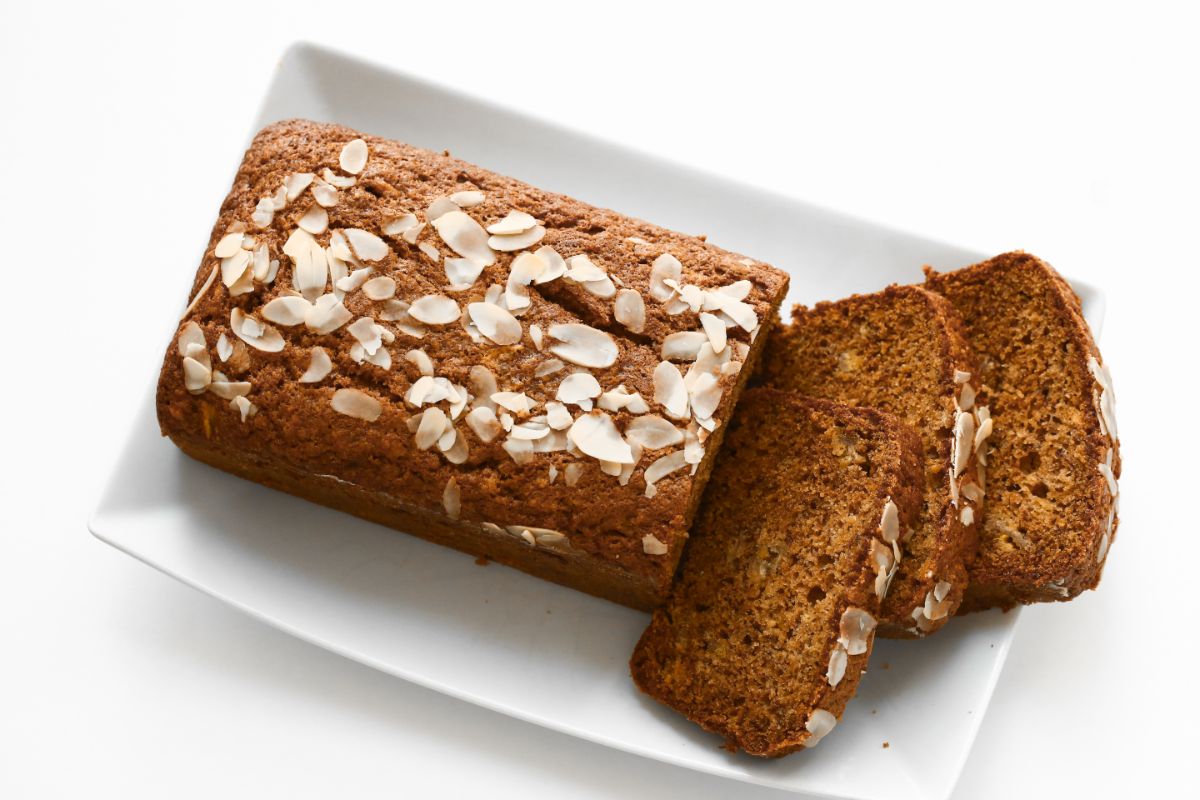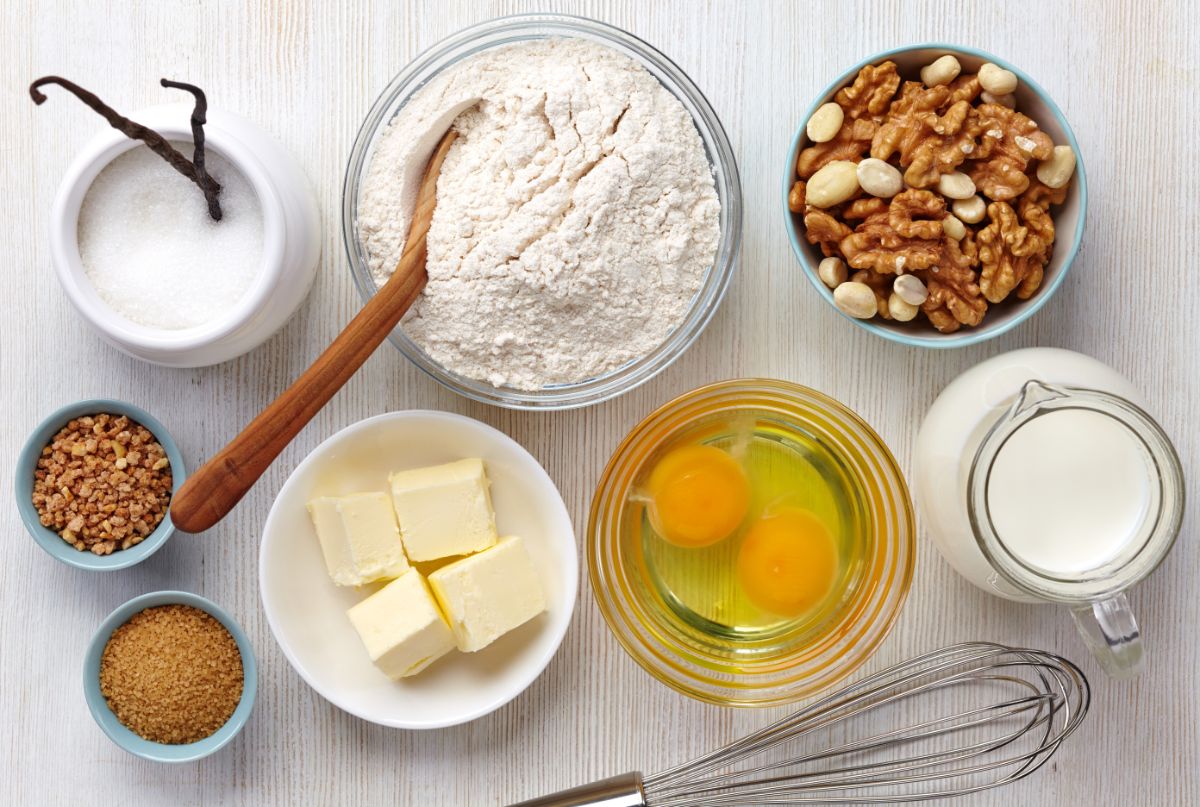
Quick bread is leavened with baking soda or baking powder instead of yeast. It’s prepared quickly without the time-consuming labor needed for traditional yeast bread. In terms of texture, the sweetened loaf is somewhere between cakes and yeast bread.
What are the five main ingredients and their functions in quick breads? The main ingredients include all-purpose flour, baking soda/baking powder, water or milk, salt, and added fat like butter.
The 5 Main Ingredients
1. Salt
If you want to know the role of salt when making quick bread, try to leave it out. Those who love bread in their diet take a substantial amount of salt.
Before you think about the right amount of salt to use, let’s look at its role. Salt adds taste to your bread and acts as a natural antioxidant.
Apart from that, it tightens the gluten structure and strengthens the dough. Any baking enthusiast will also tell you that bread cannot hold the carbon dioxide gas without salt.
Secondly, salt slows down enzyme activity. As salt and baking powder compete for water, the fermentation process slows down. Finally, salt prevents the bread from getting stale thus giving it longer shelf life.
When making quick bread, you should add 1.8% to 2% of the total amount of flour. Anything above 2.2% is considered too high. In the UK, the recommended amount is 1g for every 100 grams of flour.
For example, if you’re making 700g of dough you should use 8g of salt. Instead of using the percentage, you can get a precise figure when you consider the number of grams. This explains why most recipes recommend 1 tbsp. of salt. Adding too much salt to your dough can make yeast get out of control.
In quick bread, you simply mix all the ingredients so you don’t have to put the salt aside. But with the different types of salt out there, choosing the right one for your baking recipe can be overwhelming.
A general rule of thumb is to use salt with crystals that dissolve easily. While those with additives may provide additional health benefits, you must stick to salt with NaCl. To enhance the taste, avoid overlaying processed salt.
2. Flour
There is no other ingredient in baking as important as wheat flour. It contains essential proteins which trap the air bubbles. As you walk down the grocery store, you’ll see a variety of baking flours to suit your baking needs.
When choosing the flour, your goal should be to get lots of gluten formation – there’s no one choice that fits all. Flours have different levels of gluten. After you hydrate them, they interact with each other to form a network.
All-purpose flour contains a perfect balance between soft and hard flours. Alternatively, you can use bread flour due to its high protein content.
When you combine it with water, it becomes elastic and produces gas bubbles. Dough made of bread flour should be allowed to rise for 10-15 minutes to relax the gluten.
If you want to give your quick bread a chewy flavor, you should substitute whole wheat bread for all-purpose flour. Think of zucchini, banana, or pumpkin bread where you can mix all the ingredients.

Unless you’re an avid baker, you should consider all-purpose flour when making quick bread.
If you don’t like the taste of whole wheat flour, mix half bread flour with whole wheat. You can also use other flours like pastry, cake, or self-rising flour.
Flours with high protein make stronger crusty bread while those with less protein are tender. Depending on the flour you choose, the protein content can range from 5 to 15%.
Another area you should pay attention to is whether the flour is bleached or unbleached. The later produces great quick bread. It doesn’t contain chemicals that may speed up the aging process.
Freezing will help to increase the shelf life of flours. You can hardly note the difference if you’re a casual baker. If a recipe calls for a specific type of flour, using one tbsp. more can increase the protein that goes into the dough.
3. Leavening agent (baking soda or baking powder)
Baking soda and baking powder are leavening agents. They help to increase the volume and texture of quick bread. Baking powder releases carbon dioxide causing bubbles in the mixture.
It’s used instead of yeast to increase flavor. Unlike other leavening agents, baking powder minimizes the time and labor when making bread. If you examine a slice of bread, you’ll see pockets of air.
Without them, you won’t end up with bread. Baking powder is a mixture of mono-calcium phosphate, sodium bicarbonate, aluminum sulfate, and corn starch.
Baking soda works the same as baking powder. It releases carbon dioxide once it gets into contact with water and acids. This expands the dough giving the baked foods a porous structure. Unlike yeast, it’s economical and easy to handle. When making quick bread, you should add 1% of the flour weight. Be sure to blend it with dry flour.
4. Fat/butter
The most common types of fat used when making quick bread is vegetable oil or butter. It coats the gluten molecules and lubricates the bread to give some tenderness.
What’s more, fats contribute to the flavor and browning of bread. Once you walk into the chiller compartment of the local supermarket, you’ll find different fat varieties to suit your baking needs.
If you want to use butter, you should be careful of the portion because it’s high in fat. The water should also be adjusted accordingly. To achieve the best results in your baking, make sure you follow the recipe to the later.
5. Water/milk
In almost every baking recipe, you cannot overlook the importance of water. When making quick bread, you can use water, milk, or other liquids.
The role of water is to dissolve salt into the mixture and moisten the flour. Another important role is harmonizing all the substances during kneading.
Of course, all ingredients must interact with water to achieve the final flavor or texture. Liquids also help the leavening agents release carbon dioxide to make the bread rise.
Last but not least, water distributes heat throughout the baking process. Dough consistency will be determined by the amount of water you use.
A dough contains at least 40% water but the exact amount will depend on the quick bread you want to make. If you use milk, it will contribute to the browning of bread.
Quick bread can include scones, muffins, biscuits, or banana bread. They are called `quick’ because they are baked immediately after mixing. Whether you’re an avid or a professional baker, you should understand how the above ingredients form tender bread.
